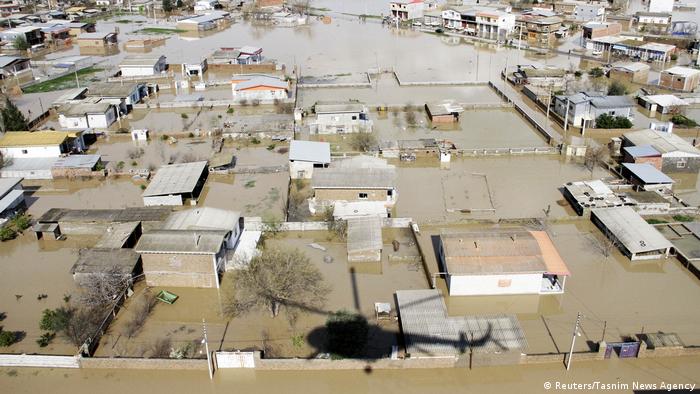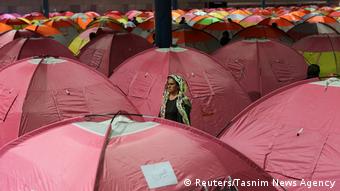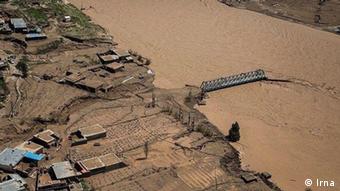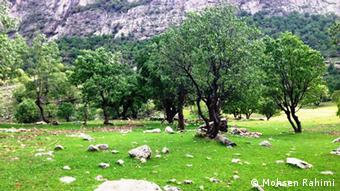After the flood disaster, the leadership pointed the Finger at the USA, the prevented with their sanctions help. But Iran must also own deficits.

Since mid-March, Iran is struggling with the consequences of the most violent Floods which have ravaged the country for decades home. According to official sources, over 70 people were killed, the opposition talk of over 200 dead. At least 26 of the 31 provinces of the country are affected, around 2000 cities and towns were flooded. Geert Jan van Oldenborgh, a climate researcher at the Royal Netherlands Meteorological Institute, told DW that within ten days, in the West of Iran, a quantity of rain fell, corresponding to the total annual precipitation in this area.
According to Radio Farda in the last week of April, new Floods in the South-Eastern provinces of Sistan and Baluchistan. Over 360,000 residents were forced to leave in all the affected regions of Iran, their homes, over two million in need, according to the Norwegian refugee work NRC help aid in the return to everyday life.
According to official Figures of the Iran’s over 14,000 kilometres of transport were damaged paths, a minimum of 314 bridges are completely collapsed. The cost of repairing the damages amounted to the equivalent of up to 2.25 billion euros

Tents do not protect sufficiently against heat and insects
.
Private aid and state measures
The Red Crescent has so far supplied over 200,000 flood victims with temporary accommodation. However, a lawyer in Ahwaz, describes the situation in Iraq and the Persian Gulf adjacent to the provincial Chusistan: “The existing tents offer no protection from heat and insects, this is a big Problem for the affected residents. At least 250 villages have been flooded in our Region and evacuated, the Situation is very critical.”
The largest part of the assistance is to be provided to the lawyer is that of civilian volunteers from the local population, for example, in the case of the preparation of meals. With its few employees, the Red could align half-moon, little, help from the state meet only with a strong delay and selectively. he was Deputy General Prosecutor for Internet crime, Javad Javidnia, had shortly after the Floods, explained that the procurement of funds by private persons or celebrities as well as the establishment of auxiliary associations for the organization of donations is prohibited. You should only be about official accounts of the Red Crescent and of the state charities settled.

Destroyed infrastructure and fields in the province of Lorestan in the West of Iran
Reconstruction in the case of poor economic situation
Civil society-help will so quickly. The rural homes that are more than 30 or 40 days under water, are no longer habitable and must be re-built completely. This is only possible by providing state funding to the farmers for compensation for crop failures and the destruction of fields need. If the necessary funds can be provided, remains to be seen. Just recently, the IMF has predicted that Iran’s economy will shrink due to the tightening of U.S. sanctions this year, and that Inflation will rise sharply.

Severe task for the government
The sins of the past take revenge
While the Iranian government blamed the U.S. government imposed sanctions for lack of assistance responsible, it is also self-criticism. For one, due to slow and cumbersome one-size-fits-governmental aid, and on the other due to the reckless building projects and interventions in river basins.
Hesameddin Naraghi, an expert of the Iranian Agency, in the case of natural disasters, said the magazine, “Iran Journal”, that the construction and the Laying of railroad tracks in the catchment area of the rivers to the disaster would have contributed. Such a construction of the area of Shiraz, and in the northeastern Iranian province of Golestan have been carried out by the revolutionary guards.
The extent of the damage had been increased by the fact that for the derivation of high-water required channels and river beds for urban development projects have been converted, without thought of the consequences. In the province of Chusestan on the southern border with Iraq had been diverted according to the expert, for the protection of oil production facilities and cane sugar factories, arms of the river Karche so that the high water could not drain into the lagoon in the Iran-Iraq border area, but the area of arable land flooded.

Iran wants to protect forests better
Consequences of deforestation long ignored
As a major cause of the flood disaster, experts see the massive decline in Iranian forest area in the past few decades. About half of the forests in the West and North of the country had been destroyed, reported the Iranian organization of natural resources and forestry. The forest areas are gone, therefore, through industrial and / or illegal deforestation as well as natural or intentional forest fires lost, among other things, in order to win land in the countryside to luxury villas and apartments. On 1. January 2017, the Iranian Parliament passed a law prohibiting further deforestation for the first four years.

